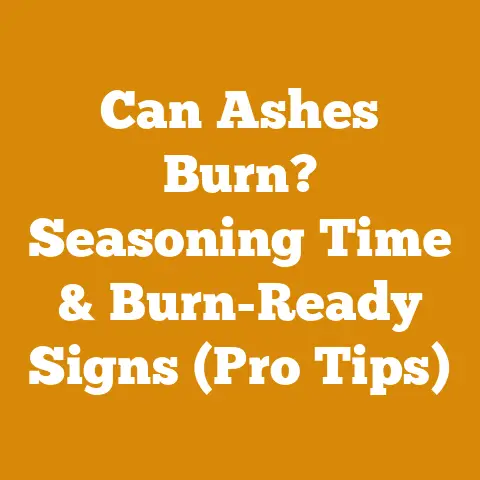Will Spectracide Kill Plants? (5 Pro Tips for Tree Care)
Investing in Your Green Assets: A Deep Dive into Tree Care and Chemical Applications
Like many of you, I’ve always believed that a healthy landscape is an investment – an investment in property value, environmental well-being, and personal enjoyment.
But sometimes, our green investments face threats, and we turn to solutions like Spectracide.
The question then becomes: “Will Spectracide kill plants?” It’s a valid concern, and understanding the answer requires a nuanced approach.
Over the years, I’ve learned that effective tree care is a delicate balance.
I remember one particularly frustrating summer battling a relentless aphid infestation on my apple trees.
I tried everything – insecticidal soap, ladybugs, even a homemade garlic spray.
Nothing seemed to work.
Finally, I considered a systemic insecticide, similar in concept to Spectracide.
The decision weighed on me.
I didn’t want to harm the beneficial insects or, worse, damage the trees themselves.
This experience, and countless others, have shaped my perspective on using chemical treatments in tree care.
It’s not about blindly spraying and hoping for the best.
It’s about understanding the product, the target pest, the potential risks, and the best practices for application.
This guide is designed to equip you with that understanding, helping you make informed decisions about Spectracide and other chemical treatments in your own landscape.
Understanding Spectracide: What It Is and What It Does
Spectracide is a brand name encompassing a range of pesticides, herbicides, and insecticides designed to control various pests and weeds in lawns and gardens.
The active ingredients vary depending on the specific Spectracide product.
Some common ingredients include:
- Pyrethrins and Pyrethroids: These are broad-spectrum insecticides derived from chrysanthemum flowers or synthesized to mimic their effects.
They work by disrupting the nervous system of insects. - Glyphosate: A non-selective herbicide that kills most plants by inhibiting a specific enzyme essential for plant growth.
- 2,4-D: A selective herbicide primarily used to control broadleaf weeds.
The potential for Spectracide to harm plants depends heavily on the specific product, the concentration used, the method of application, and the type of plant being treated.
Will Spectracide Kill Plants? Addressing the Core Question
The short answer is: yes, Spectracide can kill plants.
However, it’s not always a straightforward yes or no.
Certain Spectracide products, like those containing glyphosate, are specifically designed to kill plants.
Others, like insecticides, are intended to target insects but can still cause damage to plants if used improperly.
To better understand the risks, let’s break down the different types of Spectracide and their potential effects:
Herbicides (Weed Killers): A Clear and Present Danger to Desirable Plants
Glyphosate-Based Products: These are the most likely to kill any plant they come into contact with.
Glyphosate inhibits an enzyme crucial for plant growth, leading to yellowing, wilting, and ultimately, death.
Even accidental overspray can be devastating.- Technical Specification: Glyphosate formulations typically contain a concentration of 41% to 53.9% active ingredient.
- Safety Precaution: Always use a shield or applicator to prevent drift when spraying near desirable plants.
Selective Herbicides (e.g., 2,4-D): These are designed to target specific types of plants, usually broadleaf weeds.
While they are less likely to harm grasses, they can still damage or kill desirable broadleaf plants like flowers, shrubs, and some trees if applied incorrectly or at too high a concentration.- Technical Specification: 2,4-D products often contain a concentration of 1% to 8% active ingredient.
- Best Practice: Carefully read the label to identify the target weeds and ensure that the product is safe for use around your desired plants.
Insecticides: A More Nuanced Risk
Broad-Spectrum Insecticides: These insecticides kill a wide range of insects, including both pests and beneficial insects.
While they may not directly kill plants, they can harm them indirectly by eliminating pollinators or beneficial predators that control other pests.- Technical Data: Common broad-spectrum insecticides like pyrethrins have a relatively short residual effect, breaking down within a few days.
- Environmental Consideration: Consider the impact on non-target organisms, such as bees, before applying broad-spectrum insecticides.
Systemic Insecticides: These insecticides are absorbed by the plant and distributed throughout its tissues.
They can be effective against pests that suck sap from the plant, but they can also potentially harm the plant itself if used improperly.- Application Note: Systemic insecticides should be applied according to the label instructions, paying careful attention to dosage and timing.
Fungicides: Less Direct, but Still a Concern
- Broad-Spectrum Fungicides: While primarily designed to control fungal diseases, some fungicides can also have phytotoxic effects on plants, causing leaf burn, discoloration, or stunted growth.
- Observation: Always test a small area of the plant before applying a fungicide to the entire plant.
5 Pro Tips for Tree Care When Using Spectracide
Here are five critical tips to minimize the risk of harming your trees and other plants when using Spectracide or any chemical treatment:
1. Read the Label – Every Single Time!
This is the most crucial step.
The label is the law.
It contains vital information about:
- Target Pests/Weeds: What the product is designed to control.
- Application Rates: How much product to use per gallon of water or per square foot.
- Application Methods: How to apply the product (e.g., spraying, drenching, granular application).
- Safety Precautions: What protective gear to wear and what precautions to take to protect yourself, children, pets, and the environment.
- Environmental Hazards: Potential risks to wildlife, water sources, and beneficial insects.
- Re-Entry Intervals (REI): How long to wait before re-entering the treated area.
- Pre-Harvest Intervals (PHI): How long to wait before harvesting fruits or vegetables from treated plants.
I can’t stress this enough.
I once made the mistake of assuming I knew the correct application rate for a herbicide based on past experience.
I ended up overdosing a section of my lawn, resulting in a large, unsightly brown patch that took months to recover.
Learn from my mistake!
2. Identify Your Plants and Pests Accurately
Before applying any treatment, make sure you know exactly what you’re dealing with.
Misidentification can lead to ineffective treatments or, worse, harm to your desired plants.
- Plant Identification: Use a plant identification app, consult a local nursery, or contact your county extension office to identify the plants in your landscape.
- Pest Identification: Similarly, identify the specific pest or disease affecting your plants.
This will help you choose the most effective treatment and avoid harming beneficial insects.
I remember diagnosing a leaf spot disease on my neighbor’s roses as black spot, a common fungal infection.
I recommended a fungicide, but it didn’t work.
It turned out to be a bacterial leaf spot, which required a different approach.
Accurate diagnosis is key!
3. Spot Treat Whenever Possible
Avoid blanket applications of pesticides or herbicides.
Instead, target only the affected plants or areas.
This minimizes the risk of harming beneficial insects, non-target plants, and the environment.
- Precision Application: Use a small sprayer or applicator to apply the product directly to the target pest or weed.
- Shielding: Protect surrounding plants with a shield or piece of cardboard to prevent overspray.
I’ve found that a small paintbrush is surprisingly effective for applying herbicides to individual weeds in flower beds.
It allows for precise application and minimizes the risk of damaging nearby plants.
4. Time Your Applications Carefully
The timing of your applications can significantly impact their effectiveness and safety.
- Weather Conditions: Avoid applying pesticides or herbicides on windy days to prevent drift.
Also, avoid applying them during hot, sunny weather, as this can increase the risk of plant damage. - Life Cycle of the Pest/Weed: Apply treatments when the pest or weed is most vulnerable.
For example, some herbicides are most effective when weeds are actively growing. - Pollinator Activity: Avoid applying insecticides during peak pollinator activity, especially on flowering plants.
Apply in the early morning or late evening when bees are less active.
I once applied a herbicide to my lawn on a windy day, and the spray drifted onto my vegetable garden, killing several of my tomato plants.
Now I always check the weather forecast before applying any chemical treatment.
5. Consider Alternatives to Chemical Treatments
Before resorting to chemical treatments, explore alternative methods of pest and weed control.
These can include:
- Cultural Practices: Maintaining healthy plants through proper watering, fertilization, and pruning can make them more resistant to pests and diseases.
- Biological Control: Introducing beneficial insects or nematodes to control pests.
- Manual Removal: Hand-pulling weeds or removing infested plant parts.
- Organic Products: Using organic pesticides or herbicides derived from natural sources.
I’ve had great success using ladybugs to control aphids in my garden.
They’re a natural and effective way to keep these pests in check, and they don’t harm my plants.
Specific Spectracide Products: A Closer Look
To further illustrate the points above, let’s examine a few specific Spectracide products and their potential impacts on plants.
Spectracide Weed Stop For Lawns Plus Crabgrass Killer
- Active Ingredients: Dimethylamine salt of 2,4-D, dimethylamine salt of Mecoprop-p, dimethylamine salt of Dicamba.
- Target: Broadleaf weeds and crabgrass in lawns.
- Potential Risks: Can damage or kill desirable broadleaf plants if applied incorrectly or at too high a concentration.
May also harm grasses if over-applied or if the lawn is stressed (e.g., drought). - Technical Specification: The product typically contains a concentration of around 7.59% 2,4-D, 1.83% Mecoprop-p and 0.84% Dicamba.
- Application Tips:
- Apply only to lawns listed on the label.
- Do not apply to newly seeded lawns until after the fourth mowing.
- Do not apply when temperatures are above 90°F.
- Water the lawn thoroughly 1-2 days before application.
- Avoid spraying desirable broadleaf plants.
Spectracide Triazicide Insect Killer For Lawns & Landscapes Concentrate
- Active Ingredient: Lambda-cyhalothrin
- Target: A wide range of insects in lawns and landscapes.
- Potential Risks: Can harm beneficial insects, including pollinators and predatory insects.
May also cause leaf burn or discoloration on sensitive plants if applied at too high a concentration. - Technical Data: Lambda-cyhalothrin is a pyrethroid insecticide with a residual effect of several weeks.
- Application Tips:
- Apply in the early morning or late evening to minimize harm to pollinators.
- Avoid spraying directly on flowers.
- Use the lowest effective concentration.
- Do not apply near bodies of water.
Spectracide Weed & Grass Killer2
- Active Ingredient: Glyphosate
- Target: Kills all vegetation it contacts.
- Potential Risks: Kills all plants, including desirable ones.
- Technical Specification: Glyphosate is a non-selective herbicide that inhibits the enzyme EPSPS, which is essential for plant growth.
- Application Tips:
- Use a shield or applicator to prevent drift.
- Apply on a calm day.
- Avoid contact with desirable plants.
- Wear protective clothing and gloves.
Case Study: My Experience with Spectracide Weed Stop on Bermuda Grass
I once used Spectracide Weed Stop to control broadleaf weeds in my Bermuda grass lawn.
I followed the label instructions carefully, but I still noticed some yellowing and thinning of the grass in certain areas.
I realized that I had applied the product unevenly, resulting in some areas receiving a higher concentration than others.
To remedy the situation, I immediately watered the affected areas thoroughly to dilute the herbicide.
I also fertilized the lawn to promote new growth.
Within a few weeks, the Bermuda grass had recovered, and the weeds were gone.
This experience taught me the importance of even application and the potential for even selective herbicides to cause damage if used improperly.
Wood Processing and Tree Health: An Unexpected Connection
While this guide primarily focuses on the direct effects of Spectracide on plants, it’s important to consider the broader context of tree health and wood processing.
The health of our trees directly impacts the quality and availability of wood resources.
For example, trees weakened by pests or diseases are more susceptible to wind damage and decay, resulting in lower-quality timber.
Similarly, trees stressed by herbicide damage may exhibit slower growth and reduced wood density.
Sustainable forestry practices, including responsible pesticide use, are essential for maintaining healthy forests and ensuring a sustainable supply of wood for future generations.
Wood Moisture Content and Treatment Impact
The moisture content of wood can also influence the effectiveness and potential harm of chemical treatments.
For example, wood that is too wet may not absorb pesticides or preservatives properly, leading to ineffective treatment and potential runoff into the environment.
- Technical Specification: The ideal moisture content for treating wood with preservatives is typically between 20% and 30%.
- Practical Tip: Use a moisture meter to measure the moisture content of the wood before applying any chemical treatment.
Safety First: Protecting Yourself and the Environment
When using Spectracide or any chemical treatment, it’s essential to prioritize safety.
Always wear appropriate personal protective equipment (PPE), including:
- Gloves: To protect your skin from contact with the chemical.
- Eye Protection: To prevent splashes from getting into your eyes.
- Long Sleeves and Pants: To minimize skin exposure.
- Respirator: If you are spraying a large area or if the product is known to be highly toxic.
Also, take precautions to protect the environment:
- Avoid Spraying Near Water Sources: Prevent pesticides and herbicides from entering streams, lakes, or ponds.
- Dispose of Empty Containers Properly: Follow the label instructions for proper disposal of empty containers.
- Mix Chemicals in a Well-Ventilated Area: Avoid breathing in fumes.
I always make sure to wash my hands thoroughly after handling any chemical treatment.
It’s a simple precaution, but it can make a big difference in protecting your health.
Conclusion: Informed Decisions for a Healthy Landscape
So, will Spectracide kill plants?
The answer, as you now know, is nuanced.
It depends on the product, the application method, and the specific plants involved.
By following the tips outlined in this guide, you can minimize the risk of harming your desired plants while effectively controlling pests and weeds.
Remember, responsible tree care is an investment – an investment in the health of your landscape, the environment, and the future of our forests.
Make informed decisions, prioritize safety, and always read the label!






